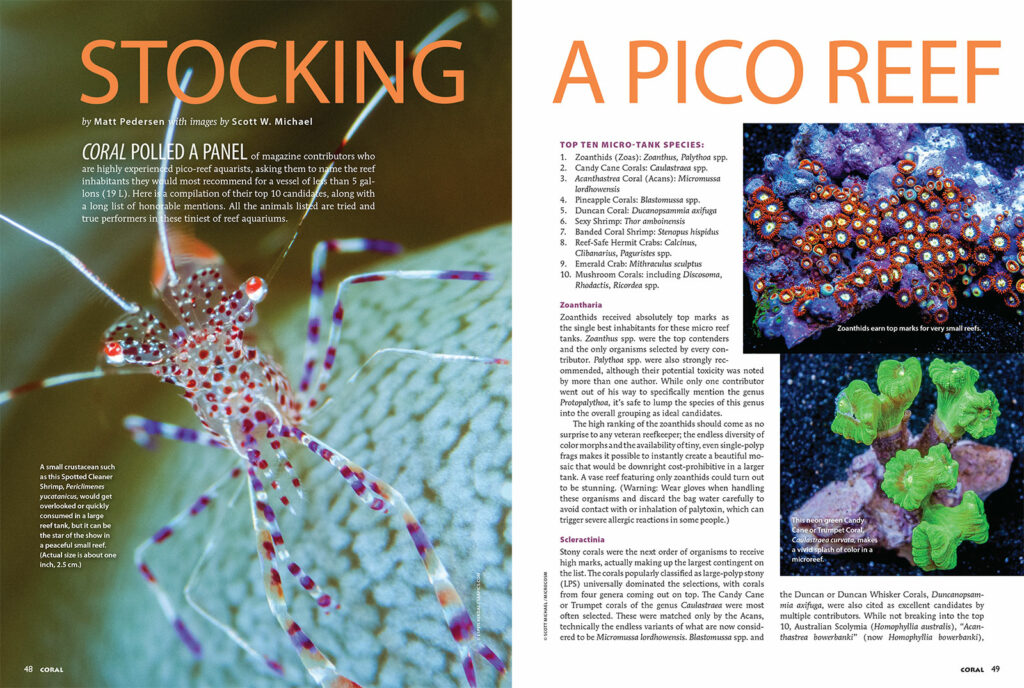
The opening pages of Stocking a Pico Reef, from the January/Febuary 2018 issue of CORAL Magazine, MICRO REEFS! All images by Scott Michael.
by Matt Pedersen, with images by Scott Michael
Excerpt from CORAL, January/February 2018
CORAL POLLED A PANEL of magazine contributors who are highly experienced pico-reef aquarists, asking them to name the reef inhabitants they would most recommend for a vessel of less than 5 gallons (19 L). Here is a compilation of their top 10 candidates, along with a long list of honorable mentions. All the animals listed are tried-and-true performers in these tiniest of reef aquariums.
TOP TEN MICRO-TANK SPECIES:
- Zoanthids (Zoas): Zoanthus, Palythoa spp.
- Candy Cane Corals: Caulastraea spp.
- Acanthastrea Coral (Acans): Micromussa lordhowensis
- Pineapple Corals: Blastomussa spp.
- Duncan Coral: Ducanopsammia axifuga
- Sexy Shrimp: Thor amboinensis
- Banded Coral Shrimp: Stenopus hispidus
- Reef-Safe Hermit Crabs: Calcinus, Clibanarius, Paguristes spp.
- Emerald Crab: Mithraculus sculptus
- Mushroom Corals, including Discosoma, Rhodactis, Ricordea spp.
Zoantharia
Zoanthids received absolutely top marks as the single best inhabitants for these micro-reef tanks. Zoanthus spp. were the top contenders and the only organisms selected by every contributor. Palythoa spp. were also strongly recommended, although their potential toxicity was noted by more than one author. While only one contributor went out of his way to specifically mention the genus Protopalythoa, it’s safe to lump the species of this genus into the overall grouping as ideal candidates.
The high ranking of the zoanthids should come as no surprise to any veteran reefkeeper; the endless diversity of color morphs and the availability of tiny, even single-polyp frags makes it possible to instantly create a beautiful mosaic that would be downright cost-prohibitive in a larger tank. A vase reef featuring only zoanthids could turn out to be stunning. (Warning: Wear gloves when handling these organisms and discard the bag water carefully to avoid contact with or inhalation of palytoxin, which can trigger severe allergic reactions in some people.)
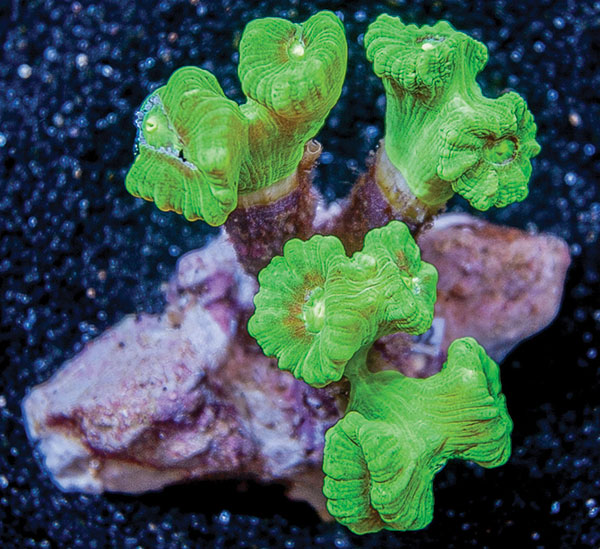
This neon green Candy Cane or Trumpet Coral, Caulastraea curvata, makes a vivid splash of color in a micro reef.
Scleractinia
Stony corals were the next order of organisms to receive high marks, actually making up the largest contingent on the list. The corals popularly classified as large-polyp stony (LPS) universally dominated the selections, with corals from four genera coming out on top. The Candy Cane or Trumpet corals of the genus Caulastraea were most often selected. These were matched only by the Acans, technically the endless variants of what are now considered to be Micromussa lordhowensis. Blastomussa spp. and the Duncan or Duncan Whisker Corals, Duncanopsammia axifuga, were also cited as excellent candidates by multiple contributors. While they didn’t break into the top 10, Australian Scolymia (Homophyllia australis), “Acanthastrea bowerbanki” (now Homophyllia bowerbanki), chalice corals (the Pectiniidae family), and Euphyllia spp. corals were also reported to have proven track records in pico reefs.
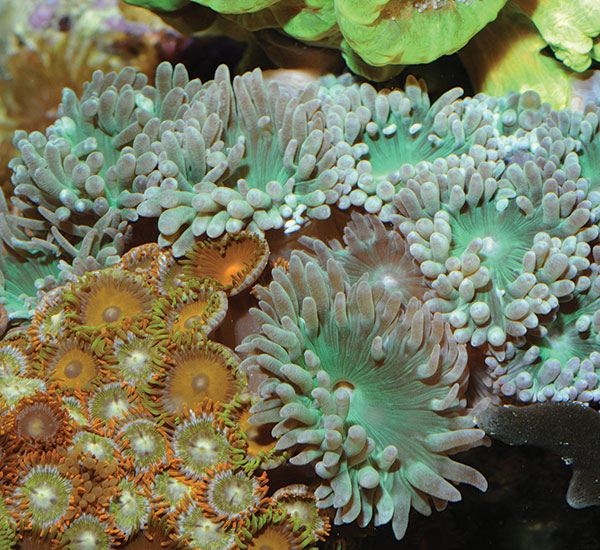
A minty green, compact form of the Duncan Coral, Duncanopsammia axifunga. These corals greatly benefit from target feeding.
Don’t let the lack of SPS and the “in-between” corals disappoint; they were frequently mentioned, but it was a broad range of species and forms with little repetition, so the odds are high that you’ll be able to succeed with whichever of these corals suits your fancy. Montipora spp. were far and away the most routinely cited corals, along with the other, traditionally more forgiving SPS corals from the genera Seriatopora and Stylophora. Pocillipora spp. would be an easy addition. Anacropora spp., Leptoseris spp., Pachyseris spp., Psammocora spp., and Cyphastrea spp. all received endorsements too. Finally, yes, Acropora is a candidate; A. valida and A. millepora have both been cultured successfully in these smallest of reef aquariums, and no doubt many others can be kept as well, provided that the keeper is ready to prune from time to time.
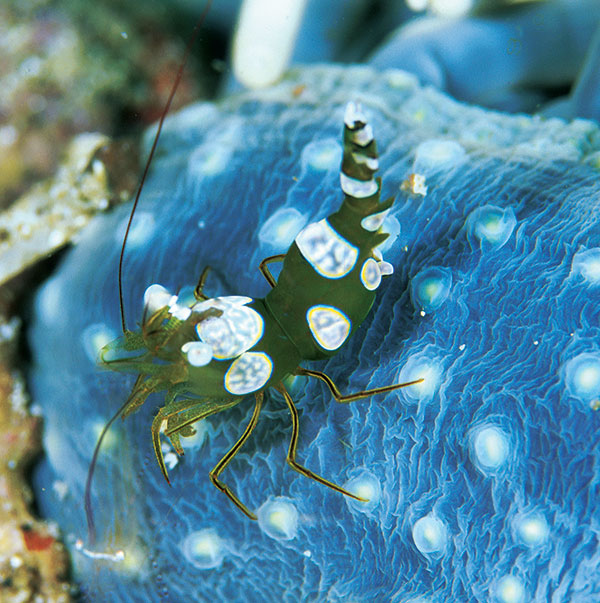
Sexy Shrimp, Thor amboinensis, are tiny enough to be kept in groups, which never fail to put on a show in small aquariums.
Decapoda
The decapods handily claimed four spots on the list, with animals we think of as shrimps (from the orders Caridea and Stenopodidea) having a slightly higher combined ranking than the crabs (Brachyura). Out of all the options presented, Sexy Shrimp (Thor amboinensis) may be truly ideal candidates for any pico reef, owing to their diminutive stature; they would simply be lost, or become food, in almost any other reef tank. Sexy Shrimp naturally reside in anemones; the Maxi-Mini Anemone (Stichodactyla tapetum) is a commonly offered natural host, but because it grows up to 6 inches (15 cm) in diameter, it might be a bit much for the smallest reefs. Thankfully, Sexy Shrimp will accept other cnidarian hosts, and they actually do not require any host to thrive in captivity if predatory fishes are absent.
Although the Coral Banded Shrimp, Stenopus hispidus, was repeatedly cited as a top candidate for these small reefs, there are better candidates within the same genus, along with many other shrimps. A large Coral Banded Shrimp may be out of place in a jar, more like Godzilla ravaging a city; better to showcase the less commonly seen Golden Coral Banded Shrimp (Stenopus scutellatus) or the even rarer Blue Coral Banded Shrimp (Stenopus tenuirostris) in a pico aquarium.
Other great shrimp candidates were mentioned, specifically the peppermint shrimps (representing multiple species of Lysmata). Pederson’s Cleaner Shrimp is an ideal candidate, owing to its small and outwardly delicate appearance; this species is now known as Ancylomenes pedersoni, although it was originally a member of the genus Periclimenes, which also contains many other small shrimps that would be equally well-suited to pico reef life. One contributor proposed the little-known hover shrimps of the genus Urocaridella as yet another excellent candidate worthy of consideration. The Bumblebee Shrimp (Gnathophyllum americanum) is another species worth looking into (but they are willing to feed on echinoderms, which may present a conflict of interest if you care to keep any sea stars).
Turning to crabs, the reef-safe hermit crabs, which represent numerous species from the genera Calcinus, Clibanarius, and Paguristes, may have first earned their places on the list due to their utility as algae eaters and scavengers. That said, these small animals are fascinating to observe, but in the long run they may get overlooked once the reef tank matures. Due to the absence of fishes in the typical tiny reef, these small hermit crabs offer a level of activity and intelligent behaviors otherwise missing. The only downside with hermits is that in such a limited space, they do tend to frequently crawl on top of corals at the bottom of the tank, although to no major ill effect.
The inclusion of the Emerald Crab, Mithraculus sculptus, likely stems from its functional role within the tank. Potentially reaching a size of 2.5 inches (6.4 cm), these crabs seem a bit domineering in the smallest of environments, but do fine in slightly larger reefs.
One contributor put in a good word for the porcelain crabs. With hundreds of described species, we cannot say that all porcelain crabs are well suited to pico-reefing, but the two commonly available species will definitely work. The Spotted Porcelain Crab, Neopetrolisthes maculatus (often misidentified in the trade under the synonym N. ohshimai), is the commonly available commensal of sea anemones. The other readily available Caribbean-sourced porcelain crab is generally identified as Petrolisthes galathinus. Both of these species are filter feeders, although they will gladly grab and consume larger food offerings.
No listing of nano crabs would be complete without proffering the anemone-wielding boxing or pom pom crabs (specifically the Indo-Pacific Lybia tessellata and its Hawaiian counterpart, L. edmondsoni). These small crabs, only 0.5 to 1 inch (1.3–2.5 cm) in size, could be the stars of the show in a tiny reef.
The Elegant Crinoid Squat Lobster, Allogalethea elegans, is neither shrimp nor crab, but it appears in a maddening array of color morphs and would make a unique pico reef inhabitant. While it is a commensal inhabitant of crinoid feather stars in the wild, it will fare well in an aquarium without its difficult-to-keep host and comes highly recommended—if you can find it.
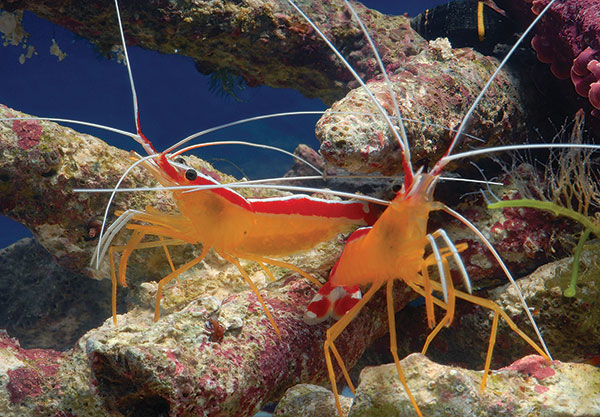
Consider size: while popular, the Skunk Cleaner Shrimp, Lysmata amboinensis, can attain an adult size of 2″(5 cm), not including the lengthy antenna—perhaps overpowering in a very tiny reef.
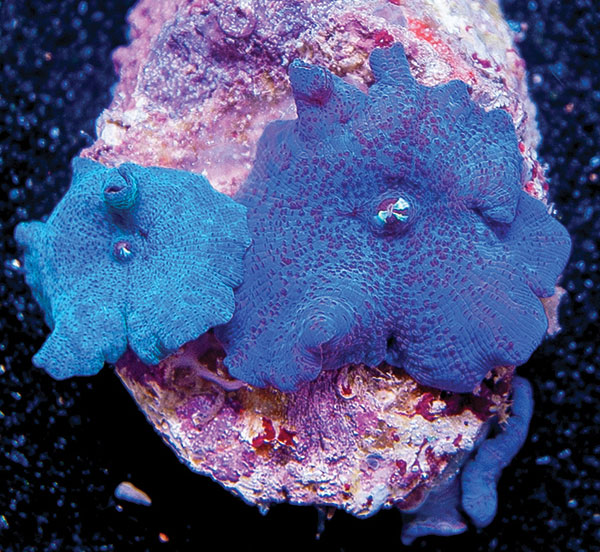
Blue mushrooms (Discosoma sp.) offer an easy splash of color. However, they can spread rapidly and overrun a small aquascape.
Corallimorpharia
Generalized as the mushroom corals and just barely securing the last spot on our top 10 list, some corallimorphs are ideal candidates for small reefs. Owing to their slower reproductive rates and great expense, members of the genus Ricordea might be the exemplary option from a group of animals that can become an overwhelming plague in some aquariums. A general recommendation would be to stay away from the genera with large and aggressive species when selecting for a pico reef.
BEYOND THE TOP 10
The aforementioned four distinct orders of life completely dominated the top 10 list, but several other groups were cited by the panel as worthy of consideration.
Octocorallia
The order Octocorallia encompasses the soft corals, including everything from leather corals and star polyps to gorgonians and beyond. Surprisingly, these generally-resilient corals were not very popular among our pico-reefing contributors. Some of the aversion may stem from the notion that you can have too much of a good thing; fast-growing soft corals can easily overwhelm a small aquarium. Nevertheless, contributors did see fit to occasionally mention star polyps (Briareum spp.) and the Pipe Organ Coral (Tubipora musica), also making general recommendations for gorgonians and leather corals. I have placed several tiny frags of the Daisy Polyp, Knopia octocontacanalis, in my own vase reef, where it is performing well. The Blue Ridge Coral, Heliopora coerulea, is often misidentified as an SPS coral or as fire corals (hydrozoans of the genus Millepora). These misunderstandings aside, this octocoral was also recommended as a great option for a pico reef.
Gastropoda
When we speak of molluscs in reef aquariums, we’re generally talking about gastropods, specifically snails. The fact that these traditional cleanup crew members were all but forgotten in our contributors’ suggestions may expose an unspoken problem: can a pico reef actually support them? Something as simple as a single Astrea or Trochus might fail to thrive if algal growth is minimal, and a dead snail isn’t exactly something you want rotting in a 1- or 2-gallon tank. Annoyingly, these snails are also known to dislodge coral frags at times. Dwarf hermit crabs may have edged out the snails because they’re able to actively feed on fare beyond algae if they’re hungry, not to mention that they can dispatch these snails anyway if they’re hungry or searching for a bigger home.
Two snails did wind up on my own list of suggestions, and both are known to reproduce freely in the aquarium. Stomatella varia and Collonista snails, which are very small in stature and are either loved or reviled by aquarists (probably in direct relation to the size of the population being kept), both received a nod as ideal candidates for pico reefs.
Macroalgae
There was absolutely no shortage of macroalgae options presented by our contributors, with red algae appearing to have a slight advantage in terms of popularity. Although this is hardly an exhaustive list of options, the varieties specifically highlighted included Caulerpa racemosa var. peltata, Chaetomorpha spp., Gracilaria hayi, Hypnea pannosa, Botryocladia spp., and Bryothamnion spp.
Echinoderms
Echinoderms representing the orders Ophiuroidea and Valvatida were deemed attention-worthy by one contributor—specifically, the ubiquitous micro or mini brittle stars and the Asterina spp. sea stars, both of which could be considered welcome residents in a pico tank.
Just Because It’s Not Listed Here…
…doesn’t mean it won’t thrive in a Lilliputian reef. While everything the experts listed can be considered tried and true, any marine organism with a truly minuscule size is a hypothetical candidate. Any form of sessile invertebrate that can be pruned for size (like a bonsai tree) arguably has a chance.
One notable absence in this discussion is the fishes; their metabolisms are much higher than that of any invertebrate life form, and their inclusion would dramatically add to the biological burden on the system. Still, that doesn’t mean it can’t be done—see Robert Fenner’s accompanying article in this issue—and quite successfully, but it might take some of the simplicity out of the system. If fishes are an absolute must, only extremely small species would have a shot at being long-term residents. The best candidates to experiment with would be nano gobies, such as the Flaming Prawn Goby (Discordipinna griessingeri), the White Cap Goby (Lotilia graciliosa), clown gobies (the smaller species of Gobiodon and Paragobiodon), and various dwarf gobies of the genus Trimma. In my own first run with a vase reef, I’m successfully housing a pair of Greenbanded Gobies (Tigrigobius mulitfasciata) in roughly 1.25 gallons [4.7 L] of water. To ease the burden that daily feedings create, culturing copepods and feeding live baby brine shrimps would be the most sensible approach to including such animals in a 1- to 2-gallon (3.8–7.6-L) vessel.
Experimentation is at the very heart of the pico reef phenomenon; if you take well-reasoned chances with an organism not listed here, be sure to share your successes and failures as you go.
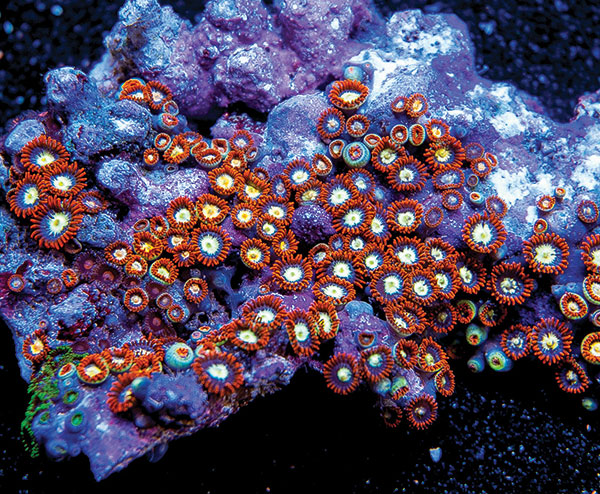
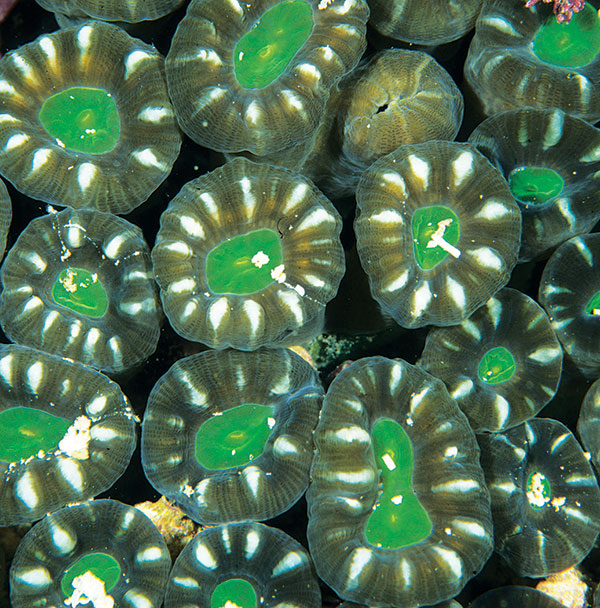
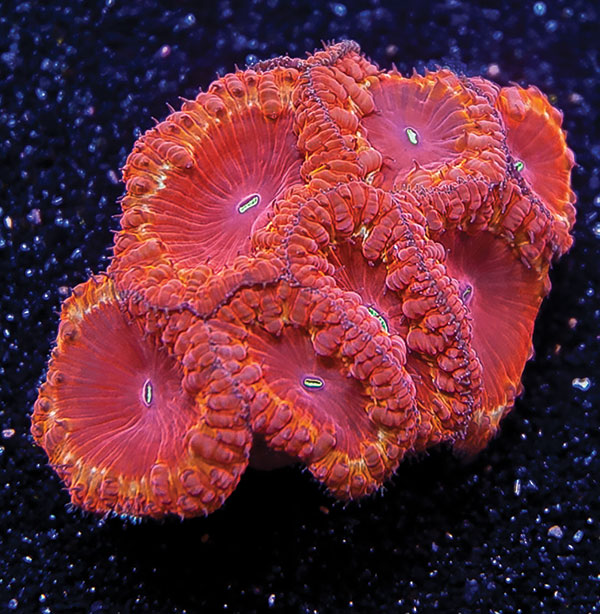
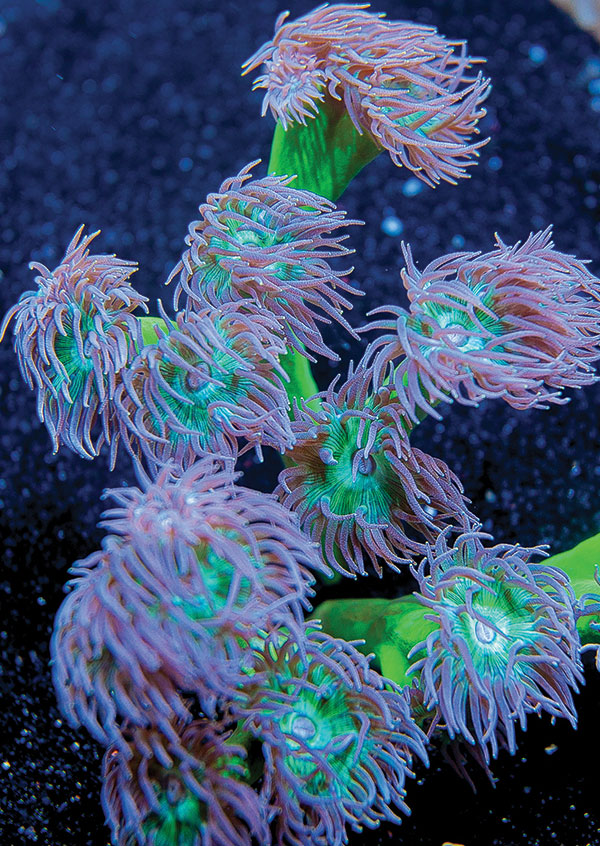
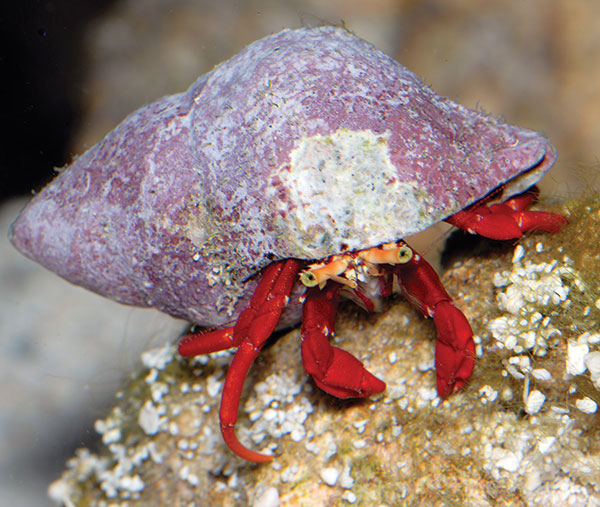
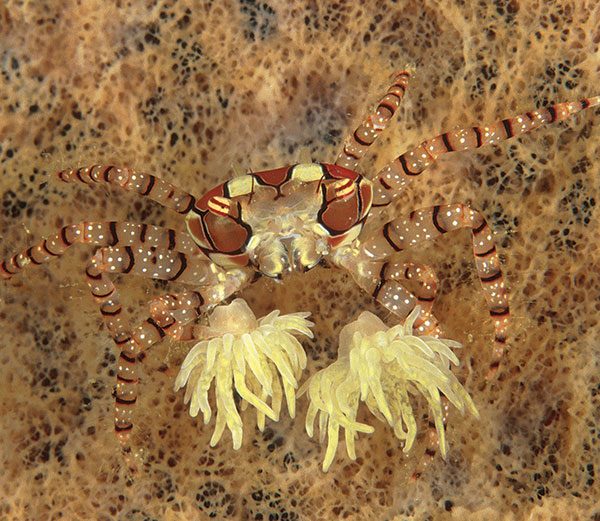
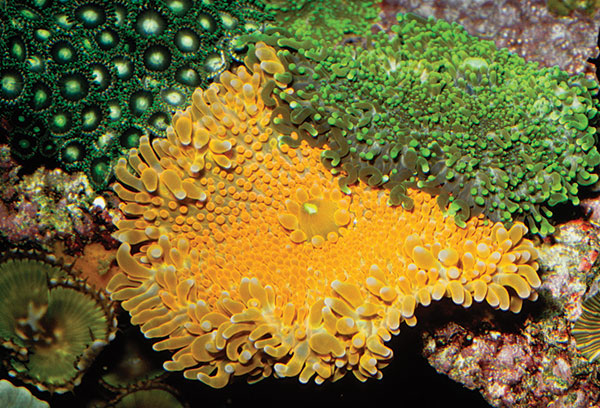





Very useful and well-written for all levels of aquarists. Thank you.
Thanks for those kind words Ross!
The best information about reef tank in simple terms that I have ever read! Nice job Matt
Thanks for the kind compliments Karen – Matt
Wow I have a 5 gallon reef and honestly this is the most in depth and detailed list of pico reef stocking options as far as what are possible and why they are possible thank you for this excellent write up!!